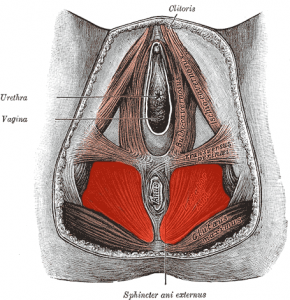 When modern man came up to stand the pelvis shifted into a new position heretofore unknown to mammals. The base of the human pelvis is the back wall of the pelvis in a quadruped or knuckle dragging ape. This is a significant difference.
When modern man came up to stand the pelvis shifted into a new position heretofore unknown to mammals. The base of the human pelvis is the back wall of the pelvis in a quadruped or knuckle dragging ape. This is a significant difference.
Before we came up to stand the ligaments and muscles of the pelvic floor were fairly weak and lax. The human pelvis is designed for stability. The fact that we walk with our legs directly underneath our hips requires a much stronger set of pelvic muscles.
Most mammalian babies come out ready to walk having developed more completely in the womb. There is an argument to be made that we are born prematurely because the new design of our human pelvis demands that we come out after nine months. Our strong and stable pelvis can’t open enough to let a head through past ten months in utero. If a cow is pregnant you can simply put your hand inside to help the calf come out. This is not an option in the human pelvis. There is access but it is extremely limited.
The pelvis has three distinct layers— the levator ani , the perineum and the sphincters–though it is also often described as the having two halves— the greater pelvis and the lesser pelvis. A diaphragm is anything that separates two parts. In the case of the pelvis, the levator ani muscle in considered to be the pelvic diaphragm separating the lesser and greater pelvis. Above the levator ani are the urinary organs and the intestines. Below the levator ani we find the perineum and the sphincters.
The levator ani muscle is actually made up of three muscles— iliococcygeus, pubocooccybeus and puborectalis—that support the bladder and intestines in men, passing just under the prostate. And the uterus, bladder, and intestines in women.
The perineum below the levator ani muscle helps to support the abdominal organs as well as playing an active role in sexual functioning, urinating, defecating, and childbirth. In order to go to the bathroom we need to relax both the perineum and the levator ani. We have conscious control over these muscles through the nervous system— it is possible to tense or relax them as needed.
The levator ani muscles actually require more resting tone than any other muscle in the body, otherwise we would be peeing all night long as we sleep. When we go to the toilet we relax these muscles.
The anal sphincters are muscles at the opening of the anus. The sphincters keeps the anus closed as waste collects through digestion. The rectum is a muscular tube about 5 inches long that connects the colon of the intestines to the anus, which is the opening where waste exits the body.
The outlets for going to the bathroom—the rectum and urethra—both pass through the pelvic floor. This is another reason why the levator ani needs more resting tone than other muscles. Very few muscles have to support something passing through them.
